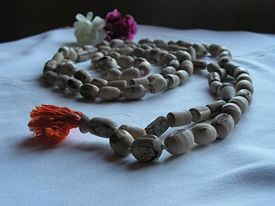Japa Mala
A Japa mala or mala (Sanskrit:माला; mālā, meaning garland[1]) is a set of beads popular in India and Buddhist countries, commonly made from 108 beads. It is used for keeping count while reciting, chanting, or mentally repeating a mantra or name/s of a particular deity, a practice known in Sanskrit as japa.
Usage
Mantras are often repeated hundreds or even thousands of times. The mala is used so that one can think about the meaning of the mantra as it is chanted rather than thinking about counting the repetitions. One mantra is usually said for every bead, turning the thumb clockwise around each bead, though some traditions or practices may call for counterclockwise or specific finger usage. When arriving at the head bead, one turns the mala around and then goes back in the same direction. This makes using the mala easier as the beads will not be so tight on the string when you use them.
If more than 108 repetitions are to be done, then sometimes in Tibetan traditions grains of rice are counted out before the chanting begins and one grain is placed in a bowl for each 108 repetitions. Each time a full mala of repetitions has been completed, one grain of rice is removed from the bowl. Often, practitioners add extra counters to their malas, usually in strings of ten. These may be positioned differently depending on the tradition; for example some traditions place these strings after every 10th bead. This is an alternative way to keep track of large numbers, sometimes going into the hundreds of thousands, and even millions.
The 109th bead on a mala is called the sumeru, bindu, stupa, or guru bead. Counting should always begin with a bead next to the sumeru. In the Hindu, Vedic tradition, if more than one mala of repetitions is to be done, one changes directions when reaching the sumeru rather than crossing it. The sumeru thus becomes the static point on the mala.
There are numerous explanations why there are 108 beads, with the number 108 bearing special religious significance in a number of Hindu and Buddhist traditions.
In Hinduism
Hindu tradition holds that the correct way to use a mala is with the right hand, with the thumb flicking one bead to the next, and with the mala draped over the middle finger. The index finger represents ego, the greatest impediment to Self-Realization, so it is considered best avoided (as with the ego) when chanting on a mala.
Regional Variations
In Northeast India, particularly those in the Shakta traditions in Bengal and Assam, the mala is often draped on the ring finger of the right hand, with beads moved by the middle finger with aid of the thumb and avoiding the use of the index finger. However, draping the mala over the middle finger and using the thumb to move the beads is also acceptable in these regions.
In Buddhism
Malas are also used in many forms of Mahayana Buddhism, often with a lesser number of beads (usually a divisor of 108). In Pure Land Buddhism, for instance, 27 bead malas are common. In China such malas are named "Shu-Zhu" (数珠); in Japan, "Juzu". These shorter malas are sometimes used for counting prostrations because they are easier to hold when enumerating repeated prostrations. In Tibetan Buddhism malas are also 108 beads: one mala counts as 100 mantras, and the 8 extra are meant to be dedicated to all sentient beings (the practice as a whole is dedicated at its end as well).
Materials
A wide variety of materials are used to make mala beads. In Hinduism, Vaishnavas generally use the Japamaala of Tulsi beads. The Shaivites use that of Rudraksha beads. Aghori practitioners typically use fragments of human skull for their malas.
Some Tibetan Buddhist traditions call for the use of bone (animal, most commonly yak) or sometimes human, the bones of past Lamas being the most valuable. Others use wood or seeds from the Bodhi tree or seeds of the Lotus plant. Semi-precious stones such as carnelian and amethyst may be used, as well. The most common and least expensive material is sandalwood. In Hindu Tantra as well as Buddhist Tantra or Vajrayana, materials and colors of the beads can relate to a specific practice.
Notes
ReferencesISBN links support NWE through referral fees
- {{{Last}}}, {{{First}}} ({{{Year}}})
External links
- General Buddhist use of mala
- How to Chant using Japa beads - Hare Krishna
- Japa Group - discussing all aspects of chanting Hare Krsna Japa
- Japa Room - A friendly and constructive way to improve your Japa online in an audio/visual chatroom environment
- Japa Yoga - Sivananda Swami
- More On Japa, by Ramana Maharshi
Credits
New World Encyclopedia writers and editors rewrote and completed the Wikipedia article in accordance with New World Encyclopedia standards. This article abides by terms of the Creative Commons CC-by-sa 3.0 License (CC-by-sa), which may be used and disseminated with proper attribution. Credit is due under the terms of this license that can reference both the New World Encyclopedia contributors and the selfless volunteer contributors of the Wikimedia Foundation. To cite this article click here for a list of acceptable citing formats.The history of earlier contributions by wikipedians is accessible to researchers here:
The history of this article since it was imported to New World Encyclopedia:
Note: Some restrictions may apply to use of individual images which are separately licensed.
